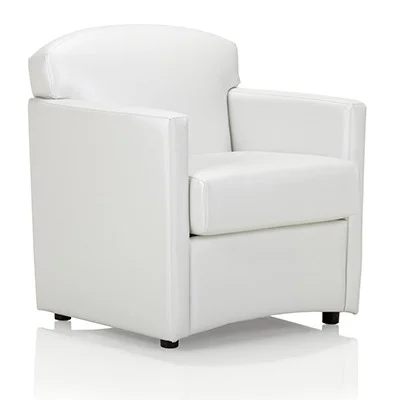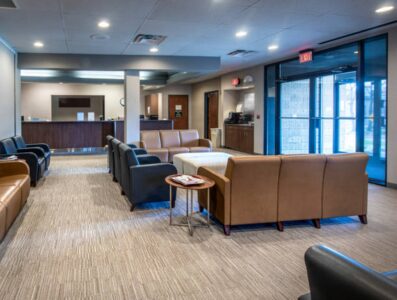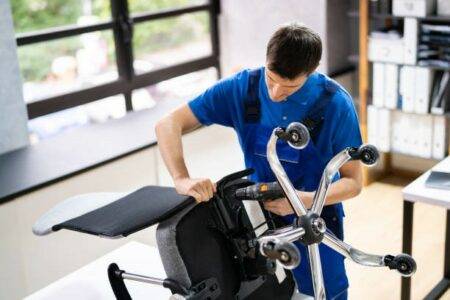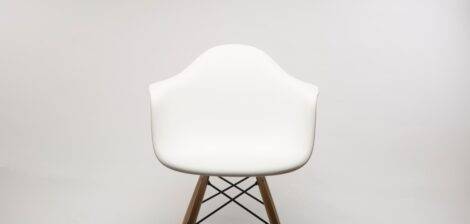Designing Senior-Friendly Spaces
When it comes to designing spaces for seniors,
ergonomic seating plays a crucial role in promoting comfort, safety, and well-being. As individuals age, their bodies undergo various changes, making it essential to understand their unique needs and provide seating solutions that cater to those requirements.
The Importance of Ergonomic Seating for Seniors
Ergonomic seating is designed to optimize comfort and support for the human body. For seniors, who may experience age-related physical limitations, ergonomic seating becomes even more important. It helps alleviate discomfort, reduces the risk of injury, and enhances overall quality of life.
By using ergonomic seating, seniors can benefit from features such as proper lumbar support, adjustable height and seat depth, and armrests that provide stability and accessibility. These features contribute to maintaining good posture, reducing strain on joints and muscles, and minimizing the risk of developing musculoskeletal issues.
Understanding the Needs of Seniors in Seating
Seniors have specific needs when it comes to seating. It’s important to consider factors such as mobility, balance, and comfort. Some common needs include:
- Supportive Backrest: Seniors require proper lumbar support to alleviate back pain and maintain good posture. Ergonomic seating solutions, such as an ergonomic office chair or an ergonomic desk chair, provide adjustable backrests that can be customized to individual preferences.
- Adjustable Height: Seniors may have difficulty getting in and out of chairs. Adjustable height options allow them to find a comfortable and safe seating position. This feature is particularly beneficial in office settings or public spaces where seating needs to accommodate a diverse range of individuals.
- Seat Depth: Adequate seat depth is essential for optimal comfort and support. Seniors often benefit from seats that are not too deep, as it allows them to maintain proper posture and avoid pressure on the back of the knees. Ergonomic seating solutions, such as an ergonomic chair, provide adjustable seat depths to accommodate different body types.
- Armrests: Armrests provide stability and support, assisting seniors in getting in and out of chairs safely. They also help reduce strain on the neck, shoulders, and arms. Ergonomic seating solutions often feature adjustable armrests, allowing seniors to find the most comfortable position for their specific needs.
Understanding the unique needs of seniors in seating is essential for creating spaces that promote their well-being and comfort. By incorporating ergonomic seating solutions, such as those designed for posture, work, gaming, pregnancy, or children, you can ensure that seniors feel supported, secure, and able to enjoy their surroundings.
Key Features of Ergonomic Seating
When it comes to creating senior-friendly spaces,
ergonomic seating plays a vital role in providing comfort, support, and accessibility for older individuals. Here are some key features to consider when selecting ergonomic seating for seniors:
Proper Lumbar Support
One of the most critical aspects of ergonomic seating for seniors is
proper lumbar support. The lower back is particularly vulnerable to discomfort and pain, especially for individuals with age-related conditions such as arthritis or osteoporosis. Ergonomic chairs with built-in lumbar support contours to the natural curvature of the spine, promoting good posture and reducing strain on the lower back. This feature helps alleviate discomfort and provides essential support during extended periods of sitting. Check out our article on
ergonomic seating for posture for more information.
Adjustable Height and Seat Depth
Seniors have varying heights and body proportions, making
adjustable height and seat depth crucial for accommodating their needs. The ability to adjust the seat height ensures that seniors can sit with their feet flat on the floor, promoting proper blood circulation and reducing strain on the legs. Similarly, adjustable seat depth allows individuals to position themselves comfortably, preventing pressure on the back of the thighs and providing optimal support. Ergonomic chairs with these adjustable features offer flexibility and customization for seniors with different body types. Learn more about ergonomic seating solutions in our article on
ergonomic seating solutions.
Armrests and Accessibility
Another essential feature of ergonomic seating for seniors is the inclusion of
armrests and accessibility. Armrests provide support for the arms and shoulders, reducing muscle strain and promoting overall comfort. For seniors with mobility challenges, it is crucial to ensure that the armrests are at an appropriate height and are easy to grip for support when getting in and out of the chair. Additionally, incorporating features like swivel functions or casters can enhance accessibility and maneuverability, making it easier for seniors to navigate their surroundings. Whether it’s in an office environment, waiting area, or home, the inclusion of ergonomic seating with accessible features can greatly improve the experience for seniors. For more information on specific types of ergonomic seating, visit our article on
ergonomic seating for work.
By prioritizing these key features in ergonomic seating, you can create comfortable and supportive environments for seniors. Whether it’s in an office setting, public spaces, or within the home, ergonomic seating that considers proper lumbar support, adjustable height and seat depth, as well as armrests and accessibility, can significantly contribute to the well-being and comfort of older individuals. Remember to consider the specific needs and preferences of seniors and consult with ergonomic seating specialists to find the best solutions for your senior-friendly space.
Types of Ergonomic Seating for Seniors
When it comes to providing comfortable and supportive seating options for seniors, there are various types of
ergonomic seating that can cater to their specific needs. These seating options are designed to promote proper posture, reduce discomfort, and enhance overall well-being. Let’s explore three popular types of ergonomic seating for seniors:
ergonomic chairs,
recliners and zero-gravity chairs, and
lift chairs.
Ergonomic Chairs
Ergonomic chairs are a versatile seating option suitable for a range of environments, including offices, homes, and public spaces. These chairs are designed with adjustable features to accommodate different body types and promote optimal comfort. Key features of ergonomic chairs include adjustable height, seat depth, and backrest angle. By customizing these settings, seniors can find a position that provides adequate support for their spine, reducing the risk of discomfort or pain.
To learn more about ergonomic chairs and their benefits, check out our article on
ergonomic chairs.
Recliners and Zero-Gravity Chairs
Recliners and zero-gravity chairs offer a unique seating experience that can be particularly beneficial for seniors. These chairs allow users to recline and elevate their legs, distributing their weight more evenly. This position helps to reduce pressure on the lower body and promote circulation, making it an excellent choice for seniors with circulation issues or mobility challenges.
Recliners and zero-gravity chairs often feature adjustable backrests and footrests, allowing seniors to find their preferred level of comfort. It’s important to choose a recliner or zero-gravity chair with adequate lumbar support to help maintain proper spinal alignment while sitting.
Lift Chairs
Lift chairs are specifically designed to assist seniors with limited mobility. These chairs feature a motorized mechanism that aids in getting in and out of the chair safely. With the push of a button, the chair lifts and tilts forward, providing a stable base for seniors to stand up or sit down without straining their muscles or joints.
Lift chairs often have additional features like adjustable positions and built-in heat and massage functions, enhancing both comfort and relaxation. When selecting a lift chair, it’s crucial to ensure that it offers the necessary support and stability for the individual’s specific needs.
By incorporating ergonomic chairs, recliners and zero-gravity chairs, and lift chairs in senior spaces, you can create an environment that prioritizes comfort and well-being. Remember to consider the unique requirements of seniors when selecting the appropriate seating option. Providing a variety of ergonomic seating choices can cater to a range of preferences and contribute to a more enjoyable and supportive experience for seniors.
Incorporating Ergonomic Seating in Senior Spaces
When it comes to creating senior-friendly spaces,
incorporating ergonomic seating is essential to ensure comfort, support, and accessibility for seniors. Whether it’s in
office environments,
waiting areas and public spaces, or
home environments, ergonomic seating can greatly enhance the well-being of seniors.
Office Environments
In office environments, where seniors may spend a significant amount of time, providing ergonomic seating is crucial. Ergonomic office chairs are designed to promote proper posture, reduce strain on the body, and enhance overall comfort. These chairs typically feature adjustable height, lumbar support, and seat depth, allowing seniors to personalize their seating experience. To learn more about ergonomic office chairs, check out our article on
ergonomic office chair.
Waiting Areas and Public Spaces
Waiting areas and public spaces, such as hospitals, clinics, and community centers, should prioritize the comfort and well-being of seniors. Incorporating ergonomic seating solutions in these spaces can help alleviate discomfort and reduce the risk of strain or injury. Providing chairs with proper lumbar support, adjustable features, and easy accessibility ensures that seniors can sit comfortably while waiting. Consider using ergonomic seating options like recliners, which provide excellent support and promote relaxation. For more information on ergonomic seating solutions, visit our article on
ergonomic seating solutions.
Home Environments
Creating a senior-friendly home environment involves carefully selecting ergonomic seating options that cater to their specific needs. In living rooms, consider using recliners or zero-gravity chairs that provide optimal support and allow seniors to find their preferred seating position. Lift chairs are also a great option for seniors with mobility issues, as they offer assistance in standing up and sitting down. These chairs can greatly improve the overall comfort and accessibility of home spaces for seniors. Learn more about ergonomic seating for home environments in our article on
ergonomic seating for home.
By incorporating ergonomic seating in office environments, waiting areas and public spaces, and home environments, businesses and individuals can ensure that seniors have access to comfortable and supportive seating options. This helps promote their overall well-being and contributes to the creation of senior-friendly spaces. Remember to consider the specific needs of seniors when selecting ergonomic seating and consult professionals for guidance if needed.
Creating a Welcoming and Comfortable Atmosphere
When designing senior-friendly spaces with ergonomic seating, it’s important to consider not only the functionality of the seating but also the overall atmosphere of the environment. Creating a welcoming and comfortable atmosphere can greatly enhance the experience for seniors. Here are some essential considerations:
color and lighting,
accessible layout and design, and
additional considerations specific to senior-friendly spaces.
Color and Lighting Considerations
The choice of colors and lighting in a space can significantly impact the mood and comfort level for seniors. When selecting colors, opt for warm and soothing tones, as they can create a calming effect. Earthy tones like beige, soft blues, and greens are often well-received. Avoid using overly bright or contrasting colors, as they can be visually overwhelming.
In terms of lighting, it’s crucial to ensure proper illumination throughout the space. Adequate lighting helps seniors navigate the area safely and comfortably. Natural light is ideal, as it provides a pleasant and inviting ambiance. However, if natural light is limited, incorporate a combination of ambient, task, and accent lighting to create a well-lit environment. Dimmable lighting options are also beneficial, as they allow for adjusting the brightness according to individual preferences and needs.
Accessible Layout and Design
Designing a space with a focus on accessibility is essential for senior-friendly environments. Ensure that there is ample space between seating areas to allow for easy maneuverability, especially for those using mobility aids such as walkers or wheelchairs. Avoid clutter and obstructions that may impede movement or create tripping hazards.
Consider incorporating features like grab bars and handrails strategically, especially in areas where seniors may need additional support, such as near seating areas or in restrooms. These features can greatly enhance safety and stability.
Additionally, make sure that seating is positioned at an appropriate height for ease of sitting and standing. Chairs with armrests can provide added support and aid in the process of sitting down and getting up. Explore our article on
ergonomic seating for more information on selecting the right chairs for various needs.
Additional Considerations for Senior-Friendly Spaces
In addition to color, lighting, and layout, there are other important considerations to keep in mind when creating senior-friendly spaces with ergonomic seating. These considerations include:
- Noise control: Minimize excessive noise levels by incorporating sound-absorbing materials and avoiding hard surfaces that cause sound reverberation.
- Temperature control: Ensure that the temperature in the space is comfortable and adjustable. Seniors may have varying temperature preferences, so providing options for individual temperature control can enhance their comfort.
- Privacy: Provide seating arrangements that offer a sense of privacy and personal space. This can be achieved through thoughtful placement of seating, partitions, or dividers.
By taking into account these various aspects, you can create a welcoming and comfortable atmosphere that caters to the specific needs of seniors. Remember to always consider the preferences and comfort of the individuals who will be utilizing the space.




















; ?>/theme/img/ecl.jpg)